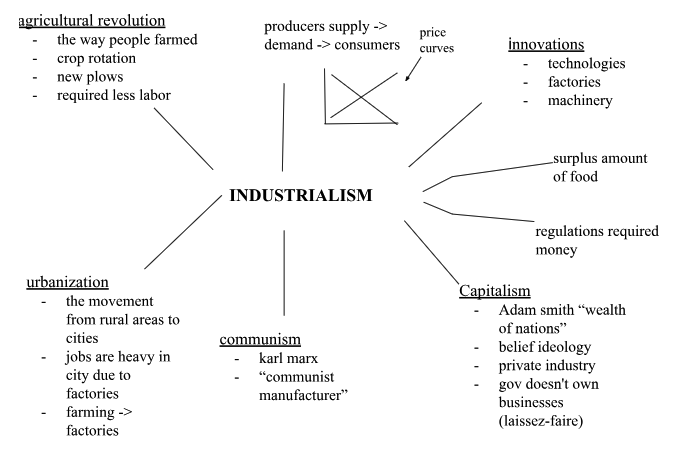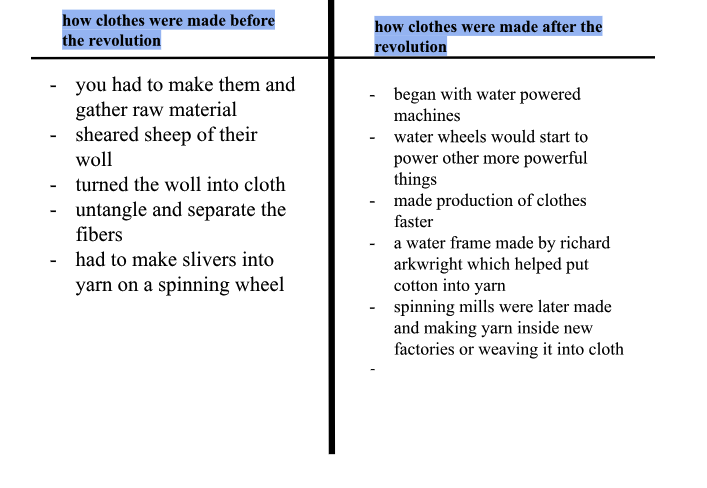5.3 Industrial Revolution begins
Vocabulary
industrialization- the development of industries in a country or religion on a wide scale
agricultural revolution- a period of time where farming techniques improved the mass cultivation of crops
urbanization- the concentration of population into urban areas
cottage system- a business of manufacturing carried on in a person’s home
factory system- a business of manufacturing in a factory
spinning jenny- a spinning frame
steam engine- an engine that uses the expansion or condensation to power
interchangeable parts- one part can replace another easily
enclosure movement-used to end traditional rights
cotton gin- separating cotton from its seeds
Learning Targets
explain how environmental factors contributed to industrialization
Context: Life before the revolution
few people worked in industrial manufacturing before the IR
mostly agricultural. huge increase in trade and never seen importance.
by 1811: 1 million families in trade/manufacturing- more than agriculture
the change was due to new inventions and demand for cotton from america
Notes
Essential Vocabulary
Revolution - An extreme political, social, or economic change
Agricultural Revolution- A change in the way Western European countries produced food using advanced technology
Industrial Revolution- A change in the way Western Europe produced goods, moving from the cottage to the factory industry
Urbanization- Movement of people from rural areas to cities
Capitalism- Economic system in which prices are based on supply and demand. The goal is profit.
Laissez-faire- Economic policy allowing businesses to operate with little or no government interference
Communism- Economic system in which everyone shares the wealth with the goal of a classless society. No private ownership exists.
Proletariat- The working class, according to Karl Marx
Adam Smith- Economic philosopher of capitalism, wrote “The Wealth of Nations”
Karl Marx- Economic philosopher of communism, wrote “The Communist Manifesto”
Irish potato famine- Period in which the potato crop failed in Ireland and millions starved or immigrated
The industrial revolution was a transition of people living a rural lifestyle to a urban lifestyle.
The growth of cities is called urbanization
Agricultural Revolution
Agricultural revolution describes the change in agriculture methods from traditional farming to more productive and innovating ways due to new technology.
The agricultural revolution led to an increase of population because of the more efficient methods of farming
The enclosure movement was the process of making common land into private land so peasants who once used common land to farm were forced to move to cities
A result of Jethro Tull’s seed drills, crop yields were increased by 5x
A new method of crop rotation called the four crop rotation system was created during the agricultural revolution, for this reason britain can produce more
Industrial rev. notes
by hand -> by machine
the industrial revolution changed political power, reordered societies, and made industrial nations rich
began in GB in 1750, before the political revolutions began
Causes of the revolution
Close prox. to waters
Rivers, canals to transport goods
Geography distribution to coal and iron
coal was a big part of the IR
Abundant access to foreign resources
massive maritime empire in other continents
Improved agricultural productivity
plenty of food
crop rotation
seed drills
new food from colombian exchange
Rapid urbanization
Less people on fields
manufacturing increase
Legal Protection of private property
Accumulation of capital
the factory system was made in places with a lot of water, which was why GB succeeded so much in beginning of the IR.
textile is going to be the first mass produced item

the first textile things mass produced was woll, once they got stuff running they realize they need more resources and begin to imperialize
GB will bring the cotton from india to make more textiles

the ind revolution was the period in which the production of goods shifted from hand production methods to complex machines. this period of industrialization resulted in social and economic changes. the industrial revolution started in G.B around 1750 . the process of industrialization spread throughout the world in the following centuries
Innovations of energy sources
What were the disadvantages to using wood and water power?
there are little areas where you can use water power so the factory places are limited, and with wood it took time to replenish the trees
Why was the use of coal an improvement on using human, animal, wood or water power for energy?
coal was an improvement because it was powered easily, because it can be set on fire and burns at a high temperature it is suitable for factories
Predict- What are the possible positive and negatives effects of the use of coal for energy?
positive: fast to get, powered easily, burns at high temperature
negative: it requires more labor than using water
Innovations in engines: james watt’s steam engine
What uses did Watt’s steam engine have during the Industrial Revolution?
changed burning coal into movement
made it possible to use coal for energy in areas not close to coal fields
runs machines for long times and high speeds
How did the steam engine improve manufacturing and transportation
made it easier and faster to manufacture
transformed transportation through railways and steamships
What are the possible positive and negatives effects of using the steam engine as a source of energy?
positive: enabling mobile power generation
negative: environmental pollution and resource depletion
Innovations in manufacturing
identify three innovations in manufacturing that took place during the industrial revolution
spinning jenny
steam engine
power loom
what are the possible positive and negative impact effects of the innovation of manufacturing
positive: improved the quality and speed of the process, cut high coasts, increase profits
negative: limits creativity, requires tons of materials
innovations in transportation
Explain how turnpikes and canals improved transportation during the Industrial Revolution?
improving the movements of goods and people
What are the possible positive and negatives effects of using turnpikes and canals to transport goods and people
positive: economic growth, reduced rural isolation
negative: habitat destruction, pollution
What earlier innovation of the Industrial Revolution was used to create the first locomotive?
?
What were the benefits of using locomotives to transport people and goods over horsepower?
made it faster and more efficient
What are the possible positive and negatives effects of using locomotives to transport goods and people?
positive: fast and efficient
negative: pollution